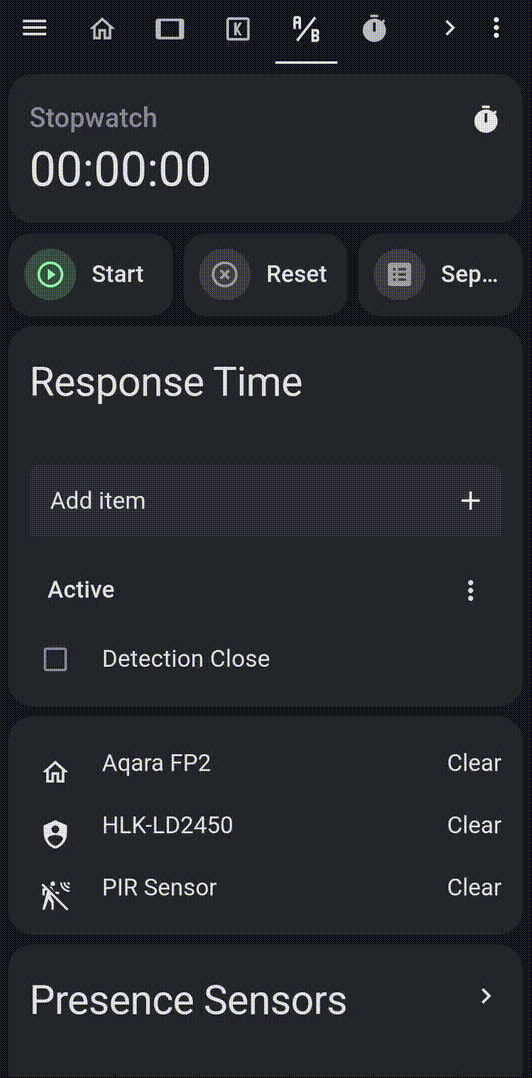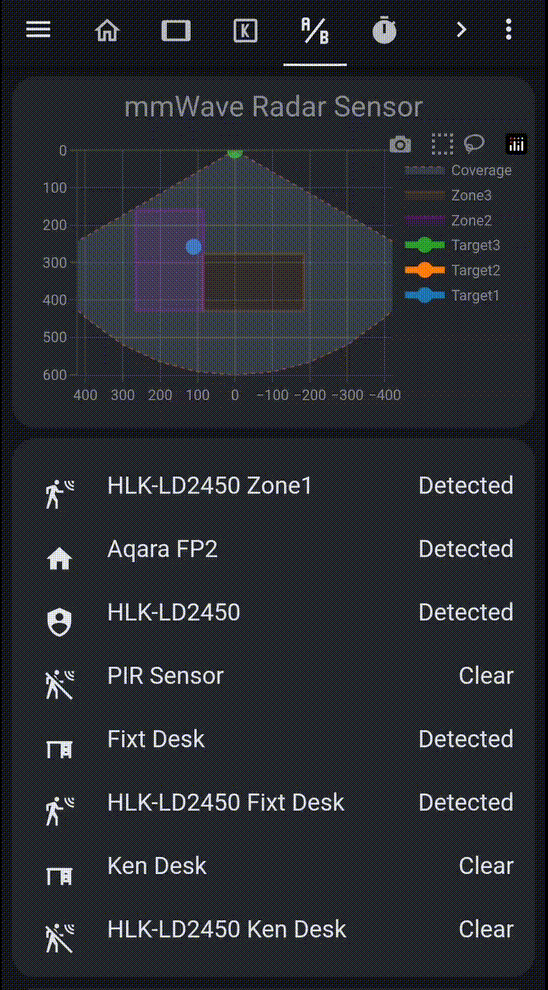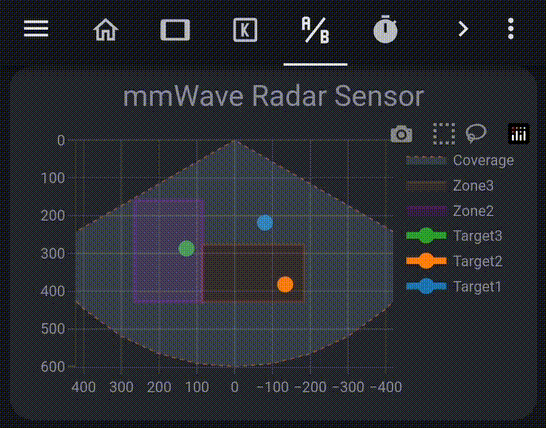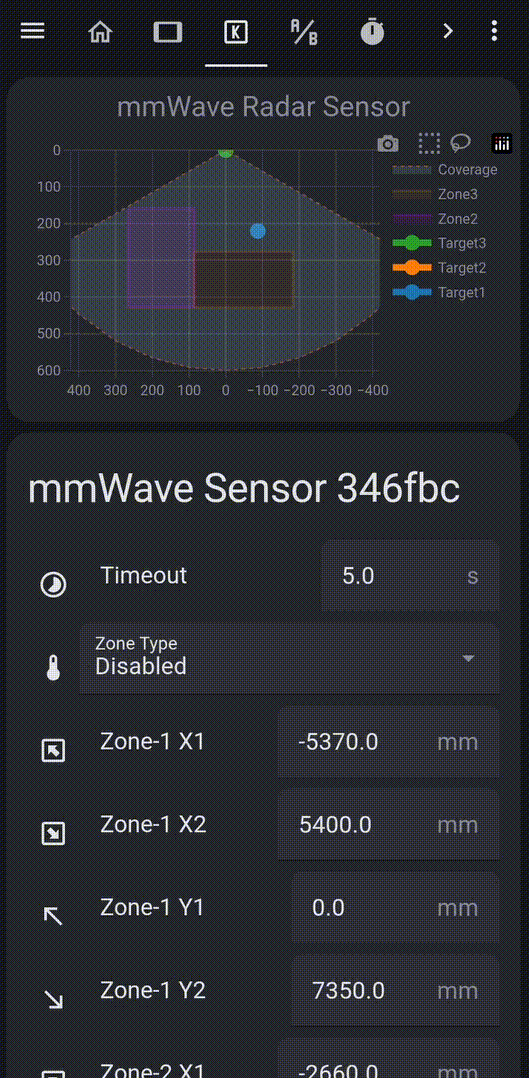Specs Comparison#
| Description | HLK-LD2450 | Aqara FP2 | PIR Sensor |
|---|---|---|---|
| Connection | Bluetooth | Wifi | Zigbee |
| Sensor | 24 GHz | 60 GHz | PIR |
| Detection Range | 6m | 9m | |
| Detection Angle | 60º | 120º | 170º |
| Zone Detection | Up to 3 | Up to 5 | No |
| Person Tracking | Yes | Yes | No |
| MultiPerson Detection | Up to 3 | Up to 10 | No |
Automated Testing Setup#

I used a modified version of the excelent Stopwatch created by miguelpucela to automate the data collection for our tests.
Response Time#
The Aqara FP2 is the clear winner here, with the fastest detection time (around 1.7s), the HLK-LD2450 is not far behind with an average of 2.2s.
The PIR sensor for reference, sits between them, with an average of 2s.
The PIR sensor for reference, sits between them, with an average of 2s.
In this case the HLK-LD2450 takes the lead, with the fastest detection time (around 1.2s), the Aqara FP2 drops to an average of 3.6s, and the PIR sensor is the slowest with an average of 5s.
On thing is clear from this, mmWave Radar technology has come a long way in recent years. These days, its detection time is lightning-fast, just like a PIR sensor.
On thing is clear from this, mmWave Radar technology has come a long way in recent years. These days, its detection time is lightning-fast, just like a PIR sensor.
Zone Detection#
First, let's remember the specs a little bit, here we have a 24 GHz Radar Sensor, with a detection range of 6m and a detection angle of 60º.

Here we found a "unique" take on Zone Detection.
The HLK-LD2450 allows you to set up to 3 zones
We have to choose between 3 different Zone Types:
Sadly, we can't mix zone types.
The HLK-LD2450 allows you to set up to 3 zones
We have to choose between 3 different Zone Types:
- Disabled
- Detection
- Filter
- Detection
- Filter
Sadly, we can't mix zone types.
With either of them, Zone Mapping it's kind of a pain, since we can only draw rectangles, and we can't rotate them, so we have to play around with the sensor position to get the zones right.
Person Tracking#
This is perhaps the most interesting part of the comparison.
Since this is the key feature that will complete the Zone Detection, to give us that almost instant reaction to our Presence that we love and expect from our automations.
Since this is the key feature that will complete the Zone Detection, to give us that almost instant reaction to our Presence that we love and expect from our automations.
Again starting with the specs, the HLK-LD2450 can track up to 3 people at the same time, and it's able to detect the direction of their movement.
But here is where the more permissive Person Tracking Algorithm shows it's tail
But here is where the more permissive Person Tracking Algorithm shows it's tail

When multiple people are detected in close proximity, the sensor often becomes confused and fails to track them accurately, it just interprets them as a single person, jumping around back a forth.
So person count is not reliable enough to be used as a trigger for automations.
But you can still use zone detection reliably to trigger automations, just for example, if you use the sensor to turn on or off some light, you can set a time delay to account for the person detection error in this scenarios.
Personally, I use the zone detection feature combined with my PCs sensors to trigger the desk light, so I don't have any issues with this.
By the time I'm close enough to the desk, the light is already on, even if the sensor “fails” due to someone else being in the room, the PC is already active, so the light stays on.
So person count is not reliable enough to be used as a trigger for automations.
But you can still use zone detection reliably to trigger automations, just for example, if you use the sensor to turn on or off some light, you can set a time delay to account for the person detection error in this scenarios.
Personally, I use the zone detection feature combined with my PCs sensors to trigger the desk light, so I don't have any issues with this.
By the time I'm close enough to the desk, the light is already on, even if the sensor “fails” due to someone else being in the room, the PC is already active, so the light stays on.
Home Assistant Integration#
To be clear, the HLK-LD2450 is not directly integrated with Home Assistant, I'm using my Ultimate ESPHome Sensor to connect it to my Home Assistant instance.
The Aqara FP2 on the other hand, is directly integrated with Home Assistant through the HomeKit Integration (No need to have any other homekit product to use it).
Both of them are really easy to integrate and use, the main difference is the amount of information they expose to Home Assistant.
The HLK-LD2450 being an ESPHome Sensor, allows me to customize the data I want to expose to Home Assistant

That is why we can have a map for the HLK-LD2450 on our dashboard and not for the Aqara FP2.
Do we gain anything from this? That's for you to decide. There are some automations that I can only do with the HLK-LD2450 because of the extra data it exposes, but just potential is not enough if you end up not using it.
Who takes the crown?#
It's not that simple, both sensors have their strengths and weaknesses, and it's up to you to decide which one fits better for your use case.
If you still want me to declare a Winner, I have to say that the Aqara FP2 is still overall a better fit for most users. But the margin is not as big as you might think.
The HLK-LD2450 is a great sensor, and it's a great alternative if you are looking for a more customizable solution that also offers almost instant detection.
Where to buy them?#
Using the affiliate links below helps support the channel and all the content I create 🎉🙌
- Aqara FP2:
- Amazon: https://amzn.to/3sOX4h3
- ESP32 30 PIN Development Board
- Amazon: (3 pack)
- Aliexpress: (USB C / Micro USB)
- HLK-LD2450 mmWave Radar Sensor
- Amazon: (HLK-LD2450 Kit)
- Aliexpress: (HLK-LD2450 Kit)